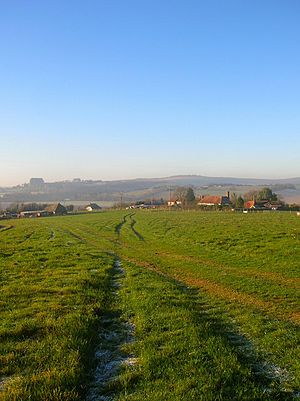Erringham chapel facts for kids
Quick facts for kids Erringham chapel |
|
|---|---|

The remains of the chapel stand on private land at Old Erringham Farm, seen here to the right. The barn is next to the large farmhouse.
|
|
| Location | Old Erringham Farm, Erringham, Shoreham-by-Sea, West Sussex, United Kingdom |
| Built | 11th century |
|
Listed Building – Grade II
|
|
| Official name: Barn 40 yards south of Old Erringham Farmhouse | |
| Designated | 8 May 1950 |
| Reference no. | 1366107 |
| Lua error in Module:Location_map at line 420: attempt to index field 'wikibase' (a nil value). | |
Erringham chapel is an old church building located in a place called Old Erringham. This area is north of Shoreham-by-Sea in West Sussex, England. It was once a "chapel of ease," which means it was a smaller church built to help people who lived far from the main church.
The chapel was built in the 11th century. It served the village of Old Erringham for many years. However, the village eventually became empty, and the chapel fell into ruin. Today, what's left of the chapel is part of a barn on a farm. This old structure is important for its history and architecture. It has been officially listed as a Grade II historic building by English Heritage.
Contents
The History of Erringham Chapel
Early Settlements in the Area
The land near the River Adur, where Shoreham-by-Sea is today, has been settled for a very long time. People lived here during the Iron Age and the Roman times. Later, during the Saxon era, it became a busy farming area.
Two villages grew up near the river. One was Old Shoreham, about 1.6 kilometers (1 mile) north of the English Channel. The other was Old Erringham, another 1.6 kilometers (1 mile) further north. Old Shoreham became quite important. It had a large church, St Nicolas' Church, by the year 900. In 1086, a survey called the Domesday Book recorded 76 people living there.
Old Erringham was likely started by a Saxon named Erra. It was mainly a farming village. In 1964, archaeologists found remains of a Saxon hut there. The Domesday survey in 1086 showed only seven people living in Erringham.
Building the Chapel
In the 11th century, a "chapel of ease" was built for the people of Old Erringham. This chapel was never a main parish church. It was always managed by St Nicolas' Church in Old Shoreham.
The chapel was made of flint and stone. It had a chancel (the area around the altar) and a nave (the main part where people sat). Some changes might have been made to the building in the 12th and 13th centuries. This was when Erringham briefly became more important. By the 1200s, it had a manor house and a windmill. Its population was almost as big as Old Shoreham's.
At the time of the Domesday survey, a powerful person named William de Braose, 1st Lord of Bramber owned the chapel and St Nicolas' Church. Soon after, he or his son Philip started a new town. This town was called New Shoreham. It was built closer to the river's mouth. They also built a third church there, called St Mary de Haura.
Why the Village Disappeared
The chapel was used for about 300 years. But then, the village of Old Erringham started to decline very quickly. This led to the chapel being abandoned.
Old Erringham was a busy farming village in the 13th century. Its population dropped for several reasons. One big reason was the Black Death, a terrible disease that spread in the mid-1300s. Changes in farming methods also played a part. The way the nearby River Adur flowed also changed, which affected how the land could be farmed. By the 1500s, only one farm was left in the area.
The chapel fell into disrepair. The nave disappeared, though its foundations can still be seen. Only the chancel part of the building remained standing. This part was then turned into a barn for the farm.
What Remains Today
Even today, the structure is known as "The Chapel" on maps. The east wall still has a stone window with two sections. This window shows a style that was popular between the Norman and English Gothic architecture periods. A similar style was used in the large St Mary de Haura Church in New Shoreham in the late 1100s.
The north and south walls of the chapel each have one small, narrow window. These are called lancet windows and are from the Norman era. The main entrance door is in the west wall. Newer parts of the barn include an iron roof and a concrete floor.
Erringham chapel was officially listed as a Grade II building by English Heritage on May 8, 1950. Buildings with this listing are considered "nationally important and of special interest." As of February 2001, it was one of 106 Grade II listed buildings in the Adur district. There were 119 listed buildings of all grades in the district at that time.
See also
- List of places of worship in Adur
- Listed buildings in Adur

